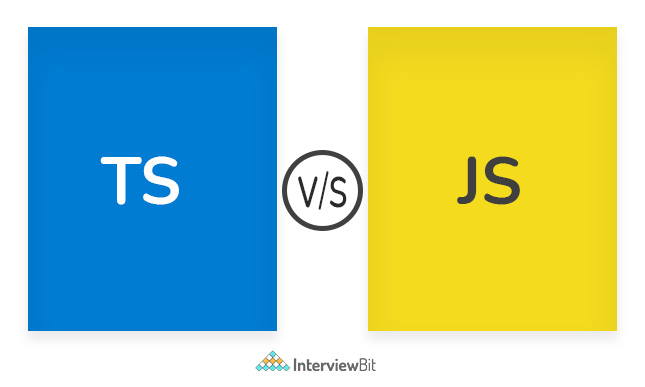Introduction
Typescript is JavaScript with types.
JavaScript is not TypeScript.
Confused right?
You must have heard about TypeScript and JavaScript. But, did you wonder, what is the difference between typescript and javascript? Did you think that typescript is a part of Javascript? Is one better than the other? If you’ve ever been a developer for a web development project, then I’m sure you’ve been exposed to JavaScript at some point in your career. Due to its ease of use and versatility, JavaScript has become one of the most popular scripting languages among software developers globally. A problem that arises, however, is the fact that any time one technology or language gains traction, a rival will rise and give it a hard time as well. A new player is on the scene – TypeScript. As TypeScript has become more and more popular, it can be seen as a lite version of JavaScript with a set of expanded features compared to its predecessor. There are a few differences between TypeScript and JavaScript, but the most prominent of them is that TypeScript is described as an object-oriented programming language. On the other hand, JavaScript is described as a prototype-based programming language.
What is JavaScript?
Javascript is a cross-platform programming language for front-end and back-end development. JavaScript is used in building web pages, backend servers, and interactive applications with interactive user experience.
It is created to make the static pages more dynamic with sophisticated features and functionality like search boxes on websites like Amazon, interactive maps, refreshing content updates on social media platforms, etc.
Confused about your next job?
JavaScript was developed in the year 1994 for only the Netscape browser to bring interaction on the webpages. It was in 1997 when the first standardized version of JavaScript was introduced by ECMAScript.
From then till today, newer versions of Javascript have been developed like ECMAScript 12 to primarily standardize the language, and provide better execution, interaction, and performance of the language.
JavaScript became the fundamental scripting language for front-end development with HTML and CSS.
Let us read about an example to get a clear idea of what functionality JavaScript bring to web pages or applications.

JavaScript is an object-oriented scripting language that allows you to add interactive elements to web pages. For example, allowing users to log in after clicking the login button is possible through JavaScript only.
Earlier JavaScript was limited to only front-end development but with the introduction of virtual engines like Google V8 and Node.js, it can also function well for server-side development as well.
For example, the set of JavaScript objects and elements like Array, Date, operators, control structures, etc provide the functionality to run JavaScript on the server as well as on the browser.
It helps in performing functions like accessing low-level I/O API, communicating with a database and so much more.
JavaScript Features
- User Input Validation: JavaScript validates user’s inputs for errors. This means that while sending the data to the server, JavaScript takes into account the user’s errors like leaving a blank space or incorrect information. It saves a lot of time while executing the code.
- Platform Independent: JavaScript is a front-end language that runs on browsers and, therefore, becomes crucial for it to be platform-independent. It is a feature that allows JavaScript code to run on different platforms like Netscape, Windows, Macintosh, etc.
- User’s Browsers and OS: JavaScript has the feature of detecting users’ browsers and operating systems. It is essential in some cases when different outputs are expected for different browsers.
- Client-side Calculations: JavaScript is a front-end language and can perform basic, simple front-end calculations without asking the server every time. It is a time saver and ensures efficiency.
What is TypeScript?
TypeScript is a programming language that is syntactical to JavaScript. It means it includes all the features of JavaScript and additional features as well.
You must be wondering then, what is the difference or why we need TypeScript? JavaScript is one of the fundamental scripting front-end languages for web development. However, there were some quirks or problems, for which Microsoft created TypeScript in 2012.
It is in the features and characteristics of the language, that lies the difference between TypeScript and JavaScript. So, let us read about the key features of JavaScript and TypeScript.

TypeScript Features
- Static Typing: Static Typing means wherein the programmer has to declare the type for a variable.
For example, suppose you take the variable name str. Unless you assign a type to it, like whether it is an Integer, Float, List, or anything, the code will not be executed. And TypeScript is statically typed.
TypeScript’s feature of Static Typing adds a lot of advantages to the language like early error detection, faster code completion, etc. - Compatibility: TypeScript is the perfect combination of old and new features. It is fully compatible with JavaScript from older versions to newer versions like ES7, and ES12. It can compile the finished code in ES7 back to ES5 and vice versa.
This ensures smooth transition and the portability of the language. - JavaScript Features: TypeScript is a superset of Javascript. With its advanced features, it includes additional features of JavaScript as well. Those features are object-oriented programming concepts, support for JavaScript libraries, platform independence, etc.
JavaScript vs TypeScript

Let us now look at the head-to-head difference between JavaScript and TypeScript.
| Parameter | JavaScript | TypeScript |
|---|---|---|
| Creator | JavaScript was developed by Brendan Eich (Netscape) in 1995. | TypeScript was created by Microsoft in the year 2012. |
| Definition | JavaScript is a scripting language with first-class functions to create dynamic web pages. | TypeScript is a powerful object-oriented language as a superset to JavaScript, with generic and JS features to overcome the complexities of JS. |
| Typing | Loosely typed. In JavaScript, only dynamic typing is supported, not static typing. | Strongly Typed. TypeScript supports both static and dynamic typing. |
| Ecosystem | JavaScript is a simple language that optimizes code for compatibility, easy to read and write. | TypeScript is more of a powerful and intuitive language that supports static typing. |
| Compilation | JavaScript does not need a compilation. | TypeScript needs to be compiled. |
| Learning Curve | JavaScript is flexible and easy to learn. | TypeScript requires specific scripting knowledge and is a little hard to learn. Plus, prior knowledge of Javascript is preferred. |
| Annotation | JavaScript does not require annotation. | TypeScript requires the need for annotation to get the full advantage of TypeScript features. |
| Prototyping | JavaScript does not have a feature for prototyping. | The prototyping feature is available in TypeScript language. |
| Error Detection | In JavaScript, errors are detected only at the run time, since it is an interpreted language. | Errors are detected or highlighted in the early development stage in TypeScript. |
| Type | JavaScript is only a scripting language that gives functionality to the pages. There is no support for interfaces. | TypeScript is an enhanced language with interfaces, OOP concepts, classes, static typing, etc. |
| Generics | JavaScript does not support generic features. | TypeScript supports generic features. It allows the creation of reusable components. |
| Community | Javascript is an old language and one of the fundamental front-end languages. Hence, it has a large community of developers. | TypeScript is a fairly new language and has a stiff learning curve. It does not have as large a community base as JavaScript. |
| Suitable | JavaScript is ideally used for web applications, mobile and desktop applications, and game development. | TypeScript is a more front-end-oriented language with rich IDE support. It is best suited for complex applications and also any JS applications as well. |
| Execution | JavaScript runs directly on the browser and supports cross-platform, cross browsers. | TypeScript does not run directly on the browser. |
| Companies using | JavaScript’s flexibility and introduction of Node.js led many companies to use JS like Netflix, Microsoft, PayPal, etc. | TypeScript with its enhanced features is used by companies like Asana, Clever, Screen Award, etc. |
Before getting to the most debatable question which is better? You should have a close look at the advantages and disadvantages of JavaScript and TypeScript.
They both have unique features and differences but the pros and cons give a better understanding of the concepts.
Pros and Cons of TypeScript and JavaScript
TypeScript Advantages
- Early Error Detection: Typescript has better features to detect bugs at an early stage. It ensures saving a lot of time for the developers and enhances the quality of the code.
- Static Typing: Declaration of a variable with a type ensures a well-structured format of the code. It also helps in finding the bugs at an early stage, increases productivity, and speeds up the process of debugging and troubleshooting.
- Rich IDE support: One reason why the TypeScript Development experience surpasses the JavaScript one is because of better IDE support. TypeScript is supported by many Integrated Development Environments like Visual Studio, WebStorm, Eclipse, etc which helps in providing a single user interface to the developer for different functionalities.
Offering features like a text editor, project editor, debugger, etc. - Power of JavaScript: TypeScript is introduced as a means to cover up the lacking features of JavaScript. Therefore, TypeScript with its features has all the advantages of JavaScript as well. Some of those pros are:
- Object-oriented concepts like inheritance, classes, encapsulation, etc ensure TypeScript’s suitability for complex projects.
- Cross-browser, Cross-platform compatibility
TypeScript Disadvantages
- Compilation: TypeScript has an added step of compiling .ts files before running them on a Node.js application. It adds one more step for the developer and adds to an unnecessary hassle. Many developers try avoiding TS for this particular reason.
- Stiff Learning Curve: TypeScript is not an easy language to learn like JS. It requires scripting knowledge. Plus, many developers believe in learning JavaScript before trying their hands at TypeScript. It affects the choice for developers to instead go for JavaScript only.
- Set Up Complexities: For programmers, TypeScript is sometimes frustrating in terms of difficulty in setting up procedures. One of the vital cons is to write everything manually and, unlike JavaScript, which is less code and more freedom, Typescript feels difficult and rigid.
JavaScript Advantages
- Interactive Language: The comprehensive UI of the scripting language, JavaScript will help you create amazing functional elements for a static web page. It induces learning, fun elements, and interaction for the programmer as well as the user.
- Supported Frameworks: JavaScript is the foundational language and quite older than TypeScript. Therefore, it has an added advantage over TypeScript as many frameworks do not support TS. JavaScript’s existing libraries and frameworks can make the process for the developer faster and more streamlined.
- Community: Developers regardless of TypeScript’s functions and features, prefer JavaScript over it. This led to a large community of developers supporting JavaScript. A community is a great support for freshers or beginners to find like-minded, experienced people who can guide you, challenge you and assist you.
- Front-end and Back-end: JavaScript was originally developed for front-end development. But with the introduction of the latest versions, supports back-end development as well. It increases the customer base for JavaScript.
JavaScript Disadvantages
- Browser Support: JavaScript code can run on different browsers. However, it in many cases has different outputs for different browsers. It increases the chances of many functions not being supported by varied browsers.
- Debugging: JavaScript’s error detection and debugging facilities are not as efficient as other programming languages. It slows down the process for developers and in times of emergencies will not have the early detection facility as well.
- Front-end Security: JavaScript code is visible to any unauthorized users or third parties. This easy access to the source code can challenge the security of the data and the web page leading to cyberattacks.
- Slow Rendering: A small or even single error could put a hold on the execution of JavaScript code. Plus, error detection is also delayed in JS.
Conclusion
The idea that one language can outdo the other, or that one is better than the other is a decision that is solely yours.
JavaScript is a foundational scripting language that still is the first choice for many developers for its versatility, extended functions, and large community. It is suitable for small projects that require dynamic web applications or mobile and desktop applications.
TypeScript, on the other hand, is a great choice for developers wherein a large codebase is involved. It is a new language but with OOP concepts and generic features and, Rich IDE support, is suitable for complex projects.
It can give developers what was lacking in JavaScript. Therefore, choosing one over another is your choice and should be made based on the project.
FAQs
Q.1: Is TypeScript frontend or backend?
Ans: TypeScript is compiled anywhere JavaScript can be used. However, it is popular among developers for its front-end technologies.
Q.2: Which is better: TypeScript or JavaScript?
Ans: This answer depends on your choice and type of project. TypeScript is best suited for complex projects while JavaScript is ideally used for small-scale projects. Here is a free course on JavaScript that will help you get started.
Q.3: Why should we not use TypeScript?
Ans: TypeScript Cons are:
- Difficult to learn
- Extra Compilation Step
- Learning Extra JavaScript Language
- Setting Up Complexities




